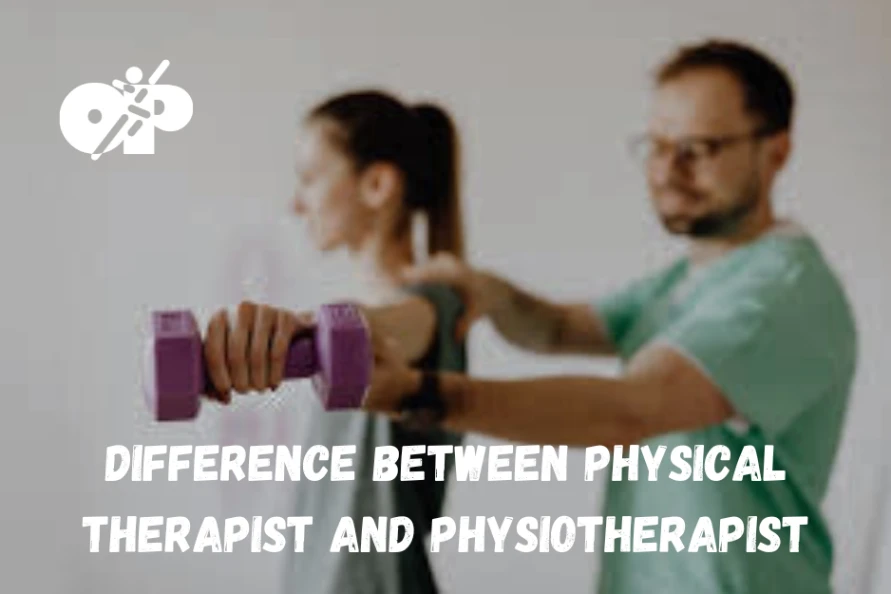Physical Therapy (PT) and Physiotherapy are two terminologies often used interchangeably, leading to much confusion and raising one of the most frequently asked questions in the healthcare field: “What is the difference between Physical Therapy and Physiotherapy?”
Physical Therapy, as defined by the American Physical Therapy Association (APTA), is a health profession concerned with promoting health, mobility, and quality of life through examination, diagnosis, prognosis, and physical intervention. Similarly, Physiotherapy, according to the World Confederation for Physical Therapy (WCPT), is a service providing methods to restore movement and function when someone is affected by injury, illness, or disability. As one can see, these definitions are quite alike, creating a common perception that these are different fields when they are not. This article aims to shed light on these therapies’ scope, principles, similarities, and differences, and their roles in modern healthcare.
Physiotherapy and Physical Therapy: Background and Evolution
The practices of Physiotherapy and Physical Therapy have rich histories, beginning in ancient times and evolving into the modern scientific disciplines we recognize today.
Ancient Origins
The therapeutic use of physical methods for healing is an ancient practice. Historical records trace back to ancient civilizations like the Greeks, Romans, and Egyptians, who used massage, hydrotherapy, and exercise to treat various ailments. Notable figures such as Hippocrates, often called the father of medicine, and Galen, a prominent Greek physician, advocated for the use of massage and manual therapy techniques.
Early Modern Developments
Fast forward to the early 19th century, the Per Henrik Ling’s “Medical Gymnastics” marked a significant evolution in this field, paving the way for modern Physiotherapy and Physical Therapy. Ling, a Swede, is now considered one of the pioneers in the field due to his development of a systematic method for healing using exercises.
The Polio Outbreak and World Wars
The most substantial leap in the development of these fields came during the polio outbreak in the early 20th century and the First and Second World Wars. The polio epidemic, which caused widespread paralysis, necessitated a structured approach for rehabilitation, thus leading to the emergence of Physiotherapy as a distinct profession.
During the World Wars, the need for rehabilitation of injured soldiers became a priority, leading to a significant expansion in the roles and recognition of Physiotherapists or Physical Therapists. In the United States, the term ‘reconstruction aides’ was used for the professionals who were the precursors to modern physical therapists.
Professionalization and Growth
In the years following the World Wars, professional organizations were established to represent the interests of Physiotherapy and Physical Therapy. In 1921, the Chartered Society of Physiotherapy was founded in the UK. The American Physical Therapy Association (APTA) was established in the US in 1921 as well. These organizations helped formalize the education and practice standards for these professions.
Over the years, the professions have evolved from predominantly exercise and massage-based practices to encompass a wide range of treatments such as manual therapy, electrotherapy, hydrotherapy, and various specialized techniques like acupuncture, ultrasound, and laser therapy. The principles have also evolved, incorporating a holistic approach focusing on the entire individual rather than just the specific ailment.
The Current Scenario and the Future
Currently, the education for Physiotherapy and Physical Therapy includes an undergraduate degree followed by a specialized postgraduate degree in many countries. Research and evidence-based practice are heavily emphasized. Physical therapists are recognized as autonomous health professionals in many parts of the world, meaning they can diagnose and treat patients without a referral from a doctor.
Today, these professions continue to evolve, incorporating advanced technology such as virtual reality and tele-rehabilitation. With an aging global population and an increase in chronic illnesses, the demand for Physiotherapy and Physical Therapy services is expected to rise significantly, making them integral parts of future healthcare systems.
Comparative Analysis: Physiotherapy and Physical Therapy
The comparative analysis of Physiotherapy and Physical Therapy largely revolves around the principles, techniques, and scope of both fields. It also considers the regional or cultural differences influencing the perception of these disciplines. We will discuss similarities and differences between both of them in details.
Similarities
The similarities between Physiotherapy and Physical Therapy are discussed below in details.
Principles
Both Physiotherapy and Physical Therapy operate under the understanding that mobility and function are fundamental to human health and well-being. They believe in the body’s inherent ability to heal and recover, and that physical interventions, such as exercises or manual therapies, can significantly aid this process. Hence, there’s no discernible difference in the guiding principles of the two.
Techniques
Both professions employ similar techniques to diagnose, treat, and prevent illnesses. These techniques typically include manual therapies, like joint mobilization and manipulation, therapeutic exercises, electrotherapy, patient education, and lifestyle advice. Additionally, they might use assistive devices, like crutches or wheelchairs, to help patients regain mobility. Despite differences in terminology, the nature and the goal of these techniques remain the same across Physiotherapy and Physical Therapy.
Scope
The scope of both Physiotherapy and Physical Therapy spans a similar range of conditions. These include musculoskeletal disorders (like arthritis, back pain, sports injuries), neurological conditions (such as stroke, Parkinson’s disease, Multiple Sclerosis), cardio-respiratory ailments (like Chronic Obstructive Pulmonary Disease, asthma), and more. They also have a significant role in post-surgical rehabilitation and management of chronic illnesses.
Rehabilitation Focus
Physiotherapy and Physical Therapy are central to the rehabilitation process. They are instrumental in helping patients recover from injuries, surgeries, strokes, and other medical conditions. Through personalized treatment plans, they guide patients towards regaining strength, flexibility, and function to return to their regular activities.
Interdisciplinary Collaboration
Physiotherapy and Physical Therapy practitioners often collaborate with other healthcare professionals, such as physicians, nurses, occupational therapists, and speech therapists, to deliver comprehensive care to patients. This interdisciplinary approach ensures holistic management of patient needs.
Recommended to Read:
- What is Preventive Physical Therapy?: A Guide to Wellbeing
- Cervicogenic Headaches? Discover Relief Through Exercise
- The Importance of Spinal Hygiene – Maintain Spine Health
Differences
Despite their near-synonymous use, the distinction between “Physical Therapy” and “Physiotherapy” is essentially regional or based on differing traditions in medical language. They are fundamentally the same in terms of underlying principles, methods of treatment, and goals. However, let’s dive into a more detailed comparison considering various perspectives.
Regional Differences in Terminology
The term “Physical Therapy” is predominantly used in the United States and a few other countries, whereas “Physiotherapy” is used more commonly in the United Kingdom, Canada, Australia, and other parts of the Commonwealth. This distinction is largely a result of language evolution and has no significant bearing on the nature of treatment provided.
Educational Differences
In some regions, the education for becoming a Physical Therapist or Physiotherapist may vary slightly. For instance, in the United States, a Doctor of Physical Therapy (DPT) degree is the entry-level requirement. However, in the UK, a degree in Physiotherapy is the standard. Despite the different titles, both education programs teach similar curriculum focusing on the restoration and improvement of human movement and function.
Regulatory Differences
The regulation of these professions can differ based on the terminology used in specific countries. In the U.S., the American Physical Therapy Association (APTA) sets the standards and guidelines for Physical Therapy. Similarly, the Chartered Society of Physiotherapy (CSP) does the same in the UK. Though they operate independently, they share common goals and often align their regulations and standards in many respects.
Cultural and Perceived Differences
Some patients or individuals may perceive differences between the two based on their experiences or societal beliefs. For example, in some regions, Physiotherapy is often associated with more traditional, hands-on, manual therapies, while Physical Therapy might be seen as more exercise-based and functional. These perceptions, however, do not represent the professions’ reality as both use a combination of manual therapies, exercise prescription, patient education, and other treatments to help patients.
Differences in Specialty Areas
While the core essence of both professions is the same, different countries may have varying specialty areas within the profession due to local demands or prevalent health issues. For instance, one might find more Physiotherapists specializing in respiratory conditions in the UK, given their robust respiratory physiotherapy practices, while there might be more Physical Therapists specializing in orthopedic conditions in the U.S. However, this isn’t a strict rule, and a wide range of specializations can be found in both professions, regardless of the terminology used.
Legislation and Licensing Requirements
The legislative frameworks and licensing requirements for Physiotherapy and Physical Therapy can differ among countries. In some regions, separate licensing and registration procedures are in place for each profession, while in others, the two may be treated as equivalent, allowing practitioners to practice interchangeably with appropriate qualifications.
Scope and Principles of Physiotherapy and Physical Therapy
Physiotherapy and Physical Therapy are dynamic professions that utilizes a broad spectrum of interventions and modalities to restore, maintain, and promote optimal physical function and health. They forms an integral part of modern healthcare systems and is applied in a variety of settings and contexts. The following is a detailed look at the principles and scope of Physiotherapy and P.
Principles of Physiotherapy and Physical Therapy
Holistic Approach Physiotherapists/Physical Therapists employ a holistic approach, meaning they consider the entire individual, not just the specific area where symptoms manifest. They acknowledge the interrelationship between physical, psychological, and social aspects of health.
Patient-Centered Care They emphasizes the importance of working with the patient as a partner in their own care. This includes shared decision-making and setting individualized, meaningful goals for each patient.
Promotion of Self-Management Both of them educate patients about their conditions and empower them to actively participate in their own recovery. This not only improves outcomes but also equips patients with the knowledge and skills to prevent future health issues.
Evidence-Based Practice The best available scientific evidence to guide their practice is utilized by the professionals of these professions. This ensures that the treatments provided are effective and appropriate for each patient’s unique condition.
Scope of Physiotherapy and Physical Therapy
Musculoskeletal This is one of the most common areas of Physiotherapy/Physical Therapy and includes the treatment of conditions such as back pain, sports injuries, arthritis, and post-surgical rehabilitation.
Neurological Therapists work with patients suffering from neurological conditions like stroke, Parkinson’s disease, and Multiple Sclerosis. They help restore function, improve mobility, and enhance the quality of life for these individuals.
Cardio-respiratory Therapists in this specialty manage and treat patients with cardiorespiratory conditions such as chronic obstructive pulmonary disease (COPD), asthma, and after cardiac surgery.
Pediatric Physiotherapists and Physical Therapists work with children suffering from a range of conditions, including those with developmental, neuromuscular, skeletal, or acquired disorders.
Geriatric Physiotherapists and Physical Therapists specialize in providing care for older adults, focusing on conditions commonly affecting this population, including arthritis, osteoporosis, cancer, Alzheimer’s disease, hip and joint replacement, and balance disorders.
Community Therapists Community therapists (PT) work outside traditional healthcare facilities, often providing home care or care in community health centers. They play a crucial role in preventive healthcare, health promotion, and improving accessibility of healthcare services.
Sports the professionals in this scope work with athletes to prevent injuries, provide treatment for injuries, and optimize performance. They also often play a role in the athlete’s rehabilitation journey back to their sport.
Women’s Health this specialty focuses on issues related to women’s health, including pregnancy-related issues, incontinence, osteoporosis, and breast cancer recovery.
Case Studies and Real-world Applications
Case studies from both fields demonstrate their effectiveness. A study on Physiotherapy’s impact on stroke patients showed improved mobility and daily living activities. Similarly, a case study on a patient with lower back pain undergoing Physical Therapy showed significant improvement in pain and function.
These therapies’ real-world applications are vast, from hospitals, outpatient clinics, home health agencies, to schools, sports, and fitness facilities. They also play a vital role in preventive healthcare and health promotion.
Role in Modern Healthcare
The roles of Physiotherapy and Physical Therapy in modern healthcare have become increasingly significant due to the rising prevalence of chronic diseases, an aging population, and growing awareness of preventive healthcare. These therapies are crucial for managing conditions, reducing disability, and improving people’s quality of life.
Future trends suggest a growing emphasis on telehealth, personalized therapy, preventive care, and advanced treatment methods integrating technology, strengthening these fields’ importance further.
Difference in Physiotherapy and Physical Therapy – Conclusion
In conclusion, Physiotherapy and Physical Therapy, despite minor regional variations in terminology, are fundamentally the same. Understanding these therapies’ principles, techniques, and scope is crucial for patients, healthcare professionals, and policy-makers alike. Their role in modern healthcare, from acute and chronic care to preventive healthcare, is undeniable, and with emerging trends and advancements, their significance is only set to increase. Regardless of the terms used, the ultimate focus remains on enhancing the health, mobility, and quality of life of individuals worldwide.





